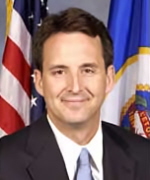Mark Dayton on Tax Policy: “I Didn’t Start the War”
DFL gubernatorial candidate launches 16 attacks against his 2010 rivals’ tax and budget plans and outgoing Pawlenty administration in hour long U of MN event

Calling taxes, “The lubricant for the machine of our democracy” and “the fuel for our social engine,” Dayton laid out his arguments for why his progressive income tax plan was both necessary to help cure the state’s budget deficit and also the fair thing to do.
Dayton called his fair tax plan “healthy for a society” and a “moral responsibility for those making tax policies.”
But at the three quarter mark into the one hour event, an audience member posed the question as to whether Dayton was engaging in class warfare.
To that, Dayton responded:
“Well, I didn’t start the war. Back under a DFL Governor Rudy Perpich and a Republican Governor Arne Carlson, there was fairly good tax equity. And look where it is today. And I haven’t had anything to do with any of those policies.”
Dayton may claim to not have started the war, but in defending his plan for the “wealthiest Minnesotans to pay no higher of a percent of their incomes in state and local taxes than they did in 1994,” the former U.S. Senator was fully armed and took several shots at both of his 2010 gubernatorial rivals, Republican Tom Emmer and Independence Party nominee Tom Horner, as well as the outgoing Tim Pawlenty administration.
In total, Dayton delivered sixteen attacks at these three political figures: four attacks directed solely at Emmer, two at Horner, five at Pawlenty, and five delivered jointly at Emmer and Horner.

“He’s previously called for the elimination of local government aid, a position he has recanted for the purposes of this campaign.”
Dayton also criticized Emmer’s tax and budget plans both for their alleged substantive problems, but also for not being substantive enough:
“Last week, however, Representative Emmer announced a budget proposal for K-12 education that would be a 4 percent cut from what current state laws’ funding formula requires for the next biennium, and a 13 percent cut if you include his failure to repay the shift.”
“(Alleviating corporate regressive tax to help small businesses) adds, as Representative Emmer did, $626 million to a deficit already projected at $5.8 billion, so now he’s up to over $6.5 billion and so then where are you going to make the offsetting cuts in the short term? And that’s a question he won’t answer.”
Dayton also attempted to use Emmer’s legislative record against him:
“Research and development – that would be another area that we’d want to recognize and provide incentives. Angel investor tax credit was passed last time – Representative Emmer voted against it, but it was good that it passed. “

“You raise the price of a pack of cigarettes $1.50 as Mr. Horner proposed, that’s money out of the pockets of working people and poorer people, and that means kids don’t have as much to eat or don’t have the same quality of food. Those are addictions, and I think you treat addictions as addictions and you don’t penalize the people who are dealing with them economically.”
“Extending the sales tax to clothing, as Mr. Horner’s proposed, is regressive. Extending the sales tax to all consumer services or whichever $2.8 billion of the $5.4 billion total that he won’t specify – but that is inherently car repair, and hair cuts, and individual purchases of lawyers and accountants and bank services and investment stock brokers and people who make their own investments as their own brokers. I mean, taxing all that and turning all those service businesses as tax collectors for the state is really a hornet’s nest and I don’t think he’s acknowledged the practical difficulties of it and he certainly hasn’t acknowledged the fact that it’s more of a regressive tax nor has he explained why again he thinks that it’s better to impose additional taxes on middle income and working families and lower middle income families and poorer families than he would on the richest people in the state by not raising their income taxes by even $1.”
Dayton also sometimes lumped Emmer and Horner together to differentiate his position from both of his opponents:
“Without making this too political, but I would point out that my two opponents are both saying that they will not raise the income tax $1 on people making $1 million or $5 million or $10 million a year.”
But Dayton also frequently painted his opponents with distinct colors – one (Horner) who has laid out plans that are problematic to solving the state’s problems, and another (Emmer) who has problematically not laid out enough details of his plans.
“What do the three candidates for governor plan to do about this? Two of the three – my worthy opponents – propose to make overall state and local taxes more regressive by extending the sales tax to clothing and “unspecified” consumer services, as Mr. Horner will admit, and to the property tax as Representative Emmer will not admit.”
“One of my principal objections to my opponent’s budget proposals – at least the one and a half of them that we have seen thus far – is that they pretend that the very significant cuts they are making will have no hardships. Mr. Horner talks about reducing state spending by some $3.5 billion through 28 “redesigns” of state government, none of which he proposes to detail until after the election. Representative Emmer on the spending side, where he has obligated himself to cutting state spending by $6.5 billion after the additional tax cut he proposed, has said only that he will “hold harmless” K-12 education which isn’t true if you actually look at his numbers. The rest of it, the over $4.5 billion in cuts that would be necessary to eliminate the state’s deficit, which he sometimes says he doesn’t even believe in, will have to wait for some future revelation, which may or may not be forthcoming before Election Day.”
Dayton also attacked his rivals for both overstating the benefits or efficacy of their budget plans as well as not fully acknowledging the harm to Minnesotans that will result from their implementation.
“But just to posit 28 redesigns of government as some antiseptic solution or explain that there are $6 billion in waste that Tim Pawlenty, the legislature, and the press and everybody else has overlooked – you can just find it and say, ‘oh – here’s the fat fat and just toss it overboard and now we’re free and clear’ – is just pure fiction.”
“And if you look at the alternatives, how my two opponents propose to raise some revenues, not as much, and where they won’t tell you that they’re going to make the cuts that are going to be necessary to offset every dollar of revenues they won’t raise, then you can assess and Minnesotans can assess for themselves which plan is fairer.”

On property tax rates:
“The property tax burden has increased by $3 billion, or about 75 percent since Governor Pawlenty became governor.”
And especially on health care:
“Governor Pawlenty showed us the wrong way to approach (health care spending) last spring by proposing this meat cleaver approach to GMAC and throwing the poorest of the poor off the health care that they had.”
“The Governor has also declined to early opt into Medicaid…and by not taking $1.4 billion in federal money for $188 million net state investment he’s again denying the poorest of the poor quality medical care, and he’s costing Minnesota more money because those people will go to emergency rooms. And he’s also denying hospitals, especially in greater Minnesota who don’t have the financial resources, he’s denying them the financial stability they need to provide quality health care for everybody.”
“Of course, when a lot of the school districts wanted to pool and buy health insurance through a pool to have lower prices and better coverage, the Governor vetoed it.”
But Dayton saved his harshest criticism of Pawlenty for last, distinguishing himself from the Governor in terms of how he would lead the state if elected:
“I won’t be off running for president, I’ll be actually in Minnesota – actually working day and night with my sleeves rolled up.”
Dayton did offer a few areas where his policies overlapped with those of his opponents, such as Representative Emmer’s tax proposal on the 10% waiver for Subchapter S and other small businesses that would allow them to retain earnings so that they could reinvest in their business. “I think that’s a good idea,” Dayton remarked.
Dayton summed up his talk by stating what the 2010 election was all about: “What’s at stake in this election is nothing less than the future of Minnesota.”
But, for the present, what is of paramount importance to the electorate is the economy and getting Minnesotans back to work. This was a final point of consensus for Dayton with his rivals:
“We all say that the elixir for what ails our state budget and our state is more jobs, and we’re all right. Representative Emmer says that, Mr. Horner says that, I say that. More jobs is what everybody should desire and strive for.”
Conversations with Minnesota’s gubernatorial candidates will continue at the Humphrey Institute over the next week: Tom Emmer will speak on Wednesday, September 15th from 1:00 to 2:00 pm. Tom Horner will speak on Monday, September 20th from 12 pm to 1:15 pm.
Follow Smart Politics on Twitter.

the problem is never that local, state and federal agencies have enough tax revenue, it’s the spending….any one who have a family budget or a business budget knows that when you have less $ you spend less…gov’t agencies never close departments…they never adjust their budgets downward and continually over reach and take and take and take…how a bout some fiscal sanity…cut back when necessary and don’t use the power of the state to take more from the people when the gov’t can’t make sound fiscal decisions.
I never could understand how Dayton could possibly imagine that his “tax the rich” scheme would close a $5.8B gap. Just look at the projections made in 2009 of revenues gained under several scenarios at: http://minnesotabudgetbites.org/2009/03/23/updated-estimates-of-various-tax-increase-proposals/ and at: http://www.mncn.org/bp/raisingrevenue.html.
The top tax brackets would have to doubled or tripled to theoretically cover the entire gap.
Moreover, consider what has happened in Oregon after it enacted “tax the rich” income tax brackets above 10%. Less than 60% of the projected revenue is being realized, leading to new calls to increase all taxes or reduce spending. The higher the tax rate, the greater the incentive to reallocate or postpone realizing taxable income like capital gains or to move to a lower tax state, so projections always overestimate the increased revenue.
One of the proposals in the 2009 reports referenced above is to assess an across the board 10% surtax on every taxpayer’s calculated income taxes as was done in the early 80’s, possibly raising $1.6B. Perhaps that is what Dayton would do after enacting the higher tax brackets to make the rates “fairer”. With a 15-20% surtax applied at the next to last line of every tax return, at least every taxpayer would be affected and would be work to reduce expenditures. That is what happened in just a few years in the 80’s. Permanently increasing income taxes, property taxes, and sales taxes provides no incentive to instill discipline in government spending.
the problem is never that local, state and federal agencies have enough tax revenue, it’s the spending….any one who have a family budget or a business budget knows that when you have less $ you spend less…gov’t agencies never close departments…they never adjust their budgets downward and continually over reach and take and take and take…how a bout some fiscal sanity…cut back when necessary and don’t use the power of the state to take more from the people when the gov’t can’t make sound fiscal decisions.